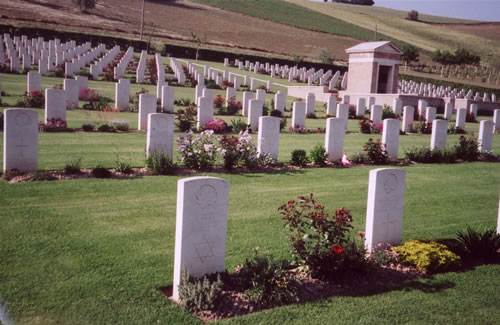Montecchio War Cemetery

The village of Montecchio was basically razed by the Germans so their field of fire could be clearly viewed. Ironically, it has since been rebuilt and has become a popular destination for German tourists. To break this end of the Gothic Line, the Canadians planned to attack from the banks of the Metauro River, several miles inland, to the coast. The Apennines provided many natural ridges and valleys favourable to defence, so casualty reports were frequent. The 1st Canadian Division set out August 25, encouraged by the following address from the 1st Canadian Corps Commander, General E.L.M. Burns:
Let everyone of us go into this battle with the determination to press forward until the enemy is destroyed; to strike and pursue until he can fight no longer. Then, and only then, shall we have won what we, as Canadians, have been fighting for - security, peace and honour for our country.
Related information
The Italian campaign - the push to Rimini
Directions
Begun as a battlefield cemetery, this site is in the rural locality of Montecchio, in the commune of Sant'Angelo (in Lizzola) and the province of Pesaro-Urbino. It is located 12 kilometres west of Pesaro and was chosen as a permanent battlefield in the autumn of 1944, when the Allies were fighting to break through the Gothic Line. During the war, Montecchio was situated on the east end and just to the south of this highly effective defensive barrier. In fact, an anti-tank ditch which formed part of the line ran through the valley that lies below the cemetery. There are 582 graves here, of which nearly half - 289 - are Canadian, including one unknown soldier. The majority are from the armoured units, and the Royal Regiment of Canadian Artillery is also heavily represented. In addition there is one member of the Royal Canadian Dental Corps. The remaining Commonwealth graves belong to the U.K., South Africa and India. Most of these soldiers gave their lives in this area in late August and September of 1944.
- Date modified: